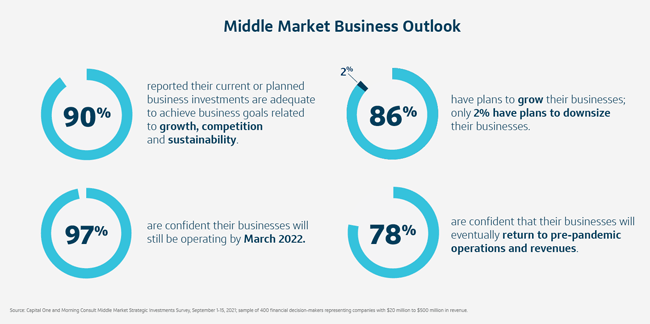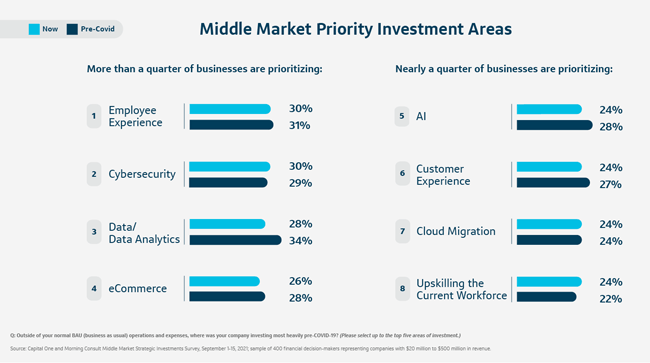
The middle market is a critical subset of the economy: When the economy grows, so does the middle market. Defined as organizations with annual revenues between $10 million and $1 billion, it is responsible for one-third of private sector GDP and employment.
Since the financial crisis of 2008, the middle market has created 30 million new jobs, a number which is projected to grow over time, making the middle market a powerhouse of the U.S. economy.
Like many aspects of the economy, much of the middle market struggled during the COVID-19 pandemic. At the close of 2019, just before COVID-19 became a global crisis, most U.S. middle market executives felt confident about their 2020 growth trajectory. Just six months later, anticipated rates of revenue and employment growth numbers plummeted.
While change and uncertainty are still in the air—and will likely have a perpetual presence in the coming months and years—the dust has started to settle. The middle market is emerging from crisis mode and looking optimistically to the future after navigating some of the toughest challenges it's ever seen.
The Middle Market Outlook
Recently Capital One and Morning Consult surveyed middle market leaders to determine their biggest business priorities and investment areas to remain competitive, achieve sustainable growth and meet business goals. The research took into account perspectives from 400 financial decision-makers representing middle market companies with revenues of $20 million to $500 million.
The good news is that this sector is back on a positive trajectory: Middle market leaders are optimistic about business conditions, and 86% have plans to grow their business through Q1 2022.

The respondents are also upbeat about what the future holds for their businesses. Nine out of ten reported that their current or planned business investments are adequate to achieve business goals.
So, the question is, what are those investment strategies?
Technology Drives growth for the Middle Market
The first major insight is the role technology is playing in middle market expansion. Business leaders have paid close attention to emerging trends and are leaning into new technologies to up level products, processes and systems to reach their business goals. Nearly all of respondents (95%) said their companies are implementing technologies that make processes and operations more efficient.
That includes data/data analytics, artificial intelligence and eCommerce. Taken together, these technologies can help improve customer retention, unlock new revenue streams and support employees in making smarter, faster decisions. For example, they can provide actionable insights about customer preferences, pain points and experiences that then lead to growth.
Companies are also doubling down on technology that supports resilience and business continuity measures.
Thirty percent of respondents said that protecting their companies from cyber threats is a top-5 investment priority today. And it shows in their investment plans: 27% of respondents expect to spend more than half a million dollars on cybersecurity in the next 1 to 3 years.
Investing in cybersecurity is a monumental task. In addition to protecting entire infrastructures and data pools, employees can also act as a defense. Education programs around business email compromise and other types of business-to-business payment fraud can be crucial in defending against these types of threats.
Barriers to Implementation
While leaders’ appetite for technology is growing, it’s important to continue to focus on workforce skills and resources. Ninety-two percent of leaders said their workforce has the skills and resources to maximize the benefits of new technology and processes, yet they also identified skills gaps in management and leadership, data analytics, machine learning, cloud computing and data science.
Furthermore, one-fifth of respondents reported that technology integration is the top challenge that keeps them up at night—more than cash flow, taxes, inflation and cost of labor. To address technology integration, some middle market companies are leaning into hiring technology talent and managing technology upgrades in-house. In other cases, they’re turning to technology partners or fintechs for customized or turnkey solutions to support digital transformation efforts.
In order to achieve a return on investment, companies need to effectively integrate these technologies and then drive adoption. Change management is hard, but it’s a huge component of generating ROI. It’s important that employees, customers, suppliers and other impacted stakeholders successfully adopt the new processes and new, digital-first experiences.
Still, leaders expect their technology investments will pay off: More than a quarter of leaders anticipated their investments in artificial intelligence and customer experience would be top drivers of ROI in the next 1 to 3 years.
The Power of Employee Experience
Another top investment area for the middle market is in employee experience and wellness, which includes wage increases and access to mental health resources, childcare and elder care. According to our research, 30% of companies said this was a top-5 area of investment today.

It’s encouraging to see companies prioritizing their people. Twenty-six percent of respondents plan to spend over $500,000 investing in employee experience and wellness in the next 1 to 3 years. These investments show that leaders value their employees and also understand the importance of employee retention, especially in today’s competitive labor market.
That competitive labor market is a key factor driving the 24% of leaders who are prioritizing investments in upskilling their current workforce. Leaders are putting in place programs and measures to achieve this goal through apprenticeships, internships and mentorships as well as continuous learning and development opportunities.
Another positive takeaway from the survey is that businesses are re-prioritizing flexibility and autonomy in the workplace. Our research found 91% of respondents said their companies are implementing technologies to allow employees to work more efficiently in a remote or hybrid environment. This is likely in response to employees’ preferences to choose the work environment that works best for them, whether it’s a traditional office space, a work-from-anywhere model or a combination of the two.
Balancing Near- and Long-term Opportunities
It’s encouraging that the middle market is on a positive trajectory. The segment’s confidence is back after successfully pivoting to face the challenges presented by the pandemic, and leaders are making smart, thoughtful choices about investment strategies.
However, as we’ve all learned over the past 18+ months, even the best laid plans and strategies must be adaptable. Many of the investments that companies are considering for the future will allow them to maintain resilience, increase agility and position them for both near- and long-term growth.